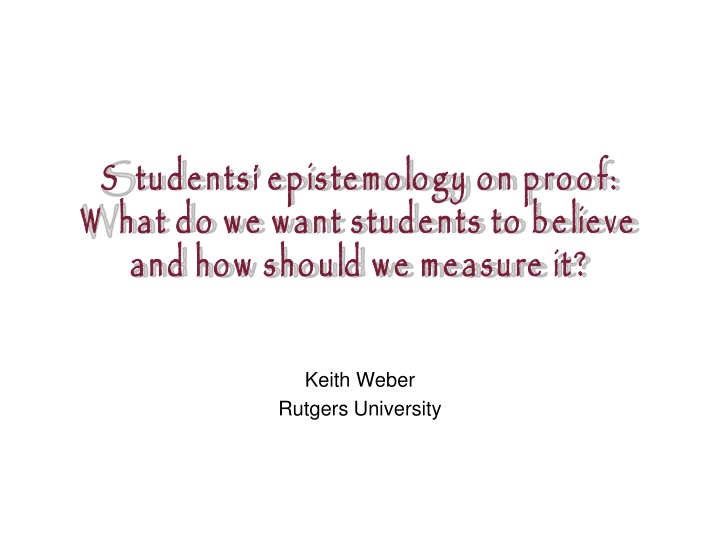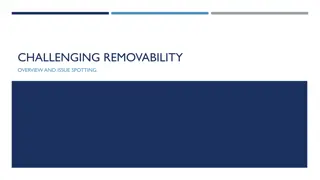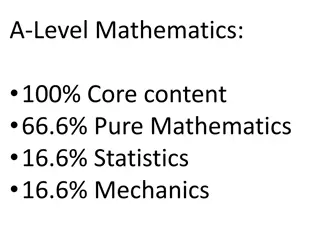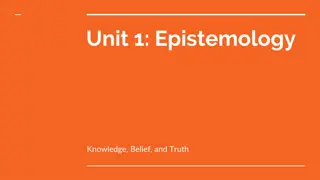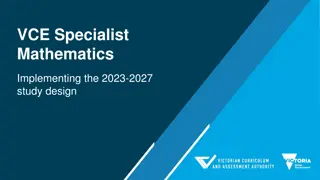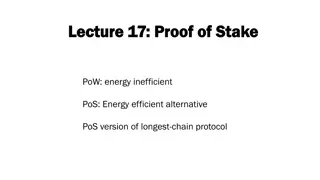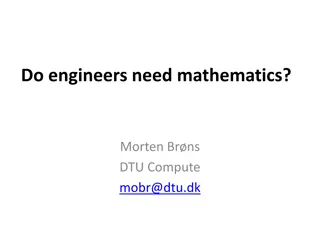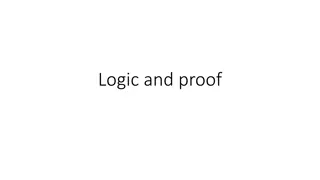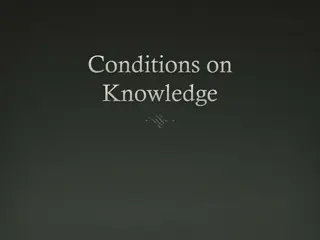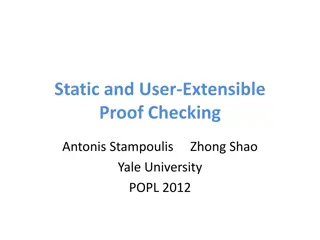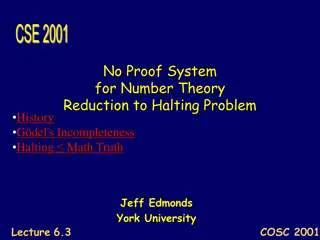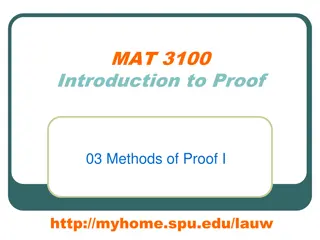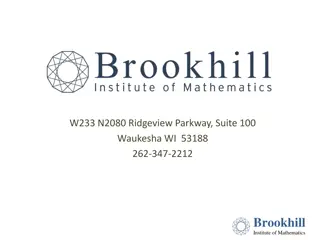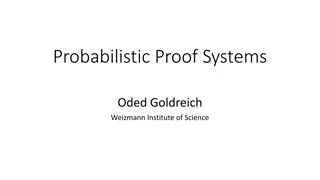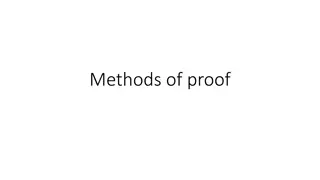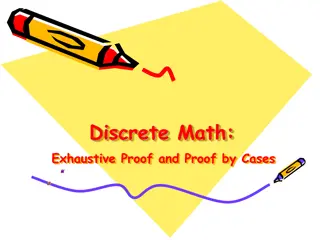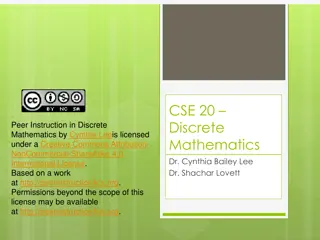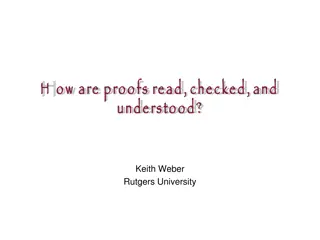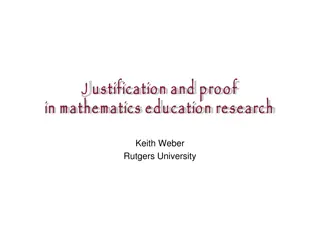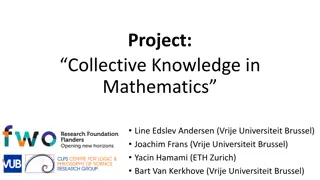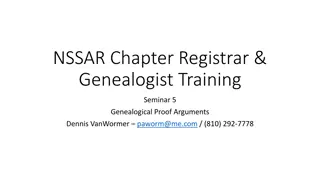Students' Epistemology on Proof in Mathematics Education
Explore the role of proof in mathematics education, focusing on how mathematicians and students approach and understand proofs. Delve into the challenges undergraduates face in justifying claims deductively and the historical shifts in investigating proof in education.
Download Presentation

Please find below an Image/Link to download the presentation.
The content on the website is provided AS IS for your information and personal use only. It may not be sold, licensed, or shared on other websites without obtaining consent from the author.If you encounter any issues during the download, it is possible that the publisher has removed the file from their server.
You are allowed to download the files provided on this website for personal or commercial use, subject to the condition that they are used lawfully. All files are the property of their respective owners.
The content on the website is provided AS IS for your information and personal use only. It may not be sold, licensed, or shared on other websites without obtaining consent from the author.
E N D
Presentation Transcript
S tudents epistemology on proof: W hat do we want students to believe and how should we measure it? S tudents epistemology on proof: W hat do we want students to believe and how should we measure it? Keith Weber Rutgers University
O utline of lectures O utline of lectures I am a mathematics educator who specializes in how undergraduates and mathematicians learn and use proof in their practice and in the classroom. I ve recently engaged in philosophical work in how proofs are written, read, and understood in logic, set theory, and recursion theory. My goal is to give a survey of mathematics education research on proof, focusing at the university level, and draw themes that you might want to consider as you bring automated theorem proving to the classroom.
C aveats C aveats I have absolutely no expertise in automated theorem proving. There is a substantial degree of heterogeneity in mathematics education research, especially on theoretical issues related to proving. There are biases and orientations that depend a lot on the region where the researchers reside. Everything I say can be interpreted with the qualifier, at least in the United States .
O utline of lectures O utline of lectures Lecture 1: Mathematicians and students epistemology with proof. Lecture 2: How are proofs read and understood? Lecture 3: The use of diagrams and instructions in proofs
T odays lecture T oday s lecture Mathematics educators focus on epistemology How do mathematicians obtain conviction? And what is the key role that proof plays? (Time permitting) Why don t undergraduates justify claims deductively?
M athematics education and their initial reluctance to investigate proof M athematics education and their initial reluctance to investigate proof In the 1980s, there was a big interest in how students and mathematicians solved (non-routine) problems. Why can t students marshal the facts and skills that they have to solve problems? How can we teach them so they do so better? Proof played an ancillary role in all of this: A proper solution to some problems involved a proof that the answer was correct. A proving task itself can be viewed as a special type of problem.
M athematics education and their initial reluctance to investigate proof M athematics education and their initial reluctance to investigate proof In the 1990s, there was a shift away from proof. In the United States, the National Council for the Teaching of Mathematics put out their 1989 Principles of School Mathematics, a comprehensive volume on what and how mathematics should be taught in the classroom. Proof was virtually absent. The word proof only appeared four times in the document. To the extent proof was mentioned, it was to say proof should receive less emphasis in secondary geometry.
MORE EMPHASIS LESS EMPHASIS Visual Representations Symbolic representations (that often mask meaning) Personal informal idiosyncratic representations Institutional standard representations Concept understanding and reasoning Collaborative group work with manipulatives and technology The production of correct products Individual paper-and-pencil work Relativist epistemologies: Good mathematics is viable to the individual using it Absolutist epistemologies: Mathematical truth is objectively correct and independent of the person studying it.
M athematics education and their initial reluctance to investigate proof M athematics education and their initial reluctance to investigate proof Mathematics educators views of proof were influenced on how proof had been treated in the school curriculum: two-column proofs in geometry, verification of trigonometric identities, and (caricatures of) the New Math curricula in the 1960s, which emphasized set theory and logic. Proof was viewed by some as: A formal symbolic object based on rules of logic Banned various non-logical types of sense making, including the use of examples and pictures An object whose correctness and permissibility was based on form, not conceptual content An object that purportedly objectively guaranteed the truth of a proposition
MORE EMPHASIS LESS EMPHASIS Visual Representations Symbolic representations (that often mask meaning) Personal informal idiosyncratic representations Institutional standard representations Concept understanding and reasoning Collaborative group work with manipulatives and technology The production of correct products Individual paper-and-pencil work Relativist epistemologies: Good mathematics is viable to the individual using it Absolutist epistemologies: Mathematical truth is objectively correct and independent of the person studying it.
A rebirth of proof A rebirth of proof The downplaying of proof was met with much criticism from mathematicians (e.g., Wu, 1996) and mathematics educators (e.g., Hanna, 1995, Schoenfeld, 1994; also Balacheff and Dreyfus). A key criticism was that the description of proof as a sequence of symbols that can be mechanically checked did not accord with what mathematicians did. Proof was a tool for gaining conviction and understanding. Proof didn t squash creativity and autonomy. If taught correctly, proof can enable it (Hanna, 1995). By 2000, the NCTM reconsidered and considered proof as a central practice that should be taught to all students. But what was counted on a a proof for young students was expanded. Knuth, E. (2000). The rebirth of proof in school mathematics in the United States. Lettre de la Preuva. Mai/Jun, 2000.
A broader conception of proof for students A broader conception of proof for students Justifications using informal natural language, or involving appeals to visual diagrams or kinesthetic actions, could qualify as proofs (at least in some contexts or for some age groups). There was a greater emphasis on the roles that proofs could play, especially conviction and explanation. (e.g., deVilliers, 1990) Proving was a social process involving debates between students. (e.g., Alibert & Thomas, 1991) Proof was often developed with technological tools, like dynamic geometry software. (e.g., Mariotti, 2007) There was a push by some to have proof emerge from students sense-making activity. (e.g., Boero et al., 1998).
MORE EMPHASIS LESS EMPHASIS Visual Representations Symbolic representations (that often mask meaning) Personal informal idiosyncratic representations Institutional standard representations Concept understanding and reasoning Collaborative group work with manipulatives and technology The production of correct products Individual paper-and-pencil work Relativist epistemologies: Good mathematics is viable to the individual using it Absolutist epistemologies: Mathematical truth is objectively correct and independent of the person studying it.
S tudents difficulties with proof are sometimes framed as an epistemological problem In a pair of influential articles, Harel and Sowder (1998, 2007) defined a proof as a justification that provided students with certainty that a statement was true. S tudents difficulties with proof are sometimes framed as an epistemological problem A student s proof scheme consists of what constitutes proving. Despite this subjective definition, the goal of instruction must be unambiguous to gradually refine students current proof schemes toward the proof scheme shared and practiced by mathematicians today . One interpretation is that students are asked to seek and obtain certainty in mathematical statements using the same evidence by which mathematicians seek and obtain certainty.
M y table has shifted somewhat M y table has shifted somewhat Relativist epistemologies still prevail, but truth is less personal and about viability, and more social or institutional and established through negotiation. There is a greater focus on activity and participation, than on personal cognition. Personal understandings and reasoning are now augmented or replaced by a focus on language. Especially in the United States, there is an equity-based critical orientation, looking at how mathematics instruction, and mathematics as a discipline, excludes underrepresented groups.
MORE EMPHASIS LESS EMPHASIS Visual Representations Symbolic representations (that often mask meaning) Personal informal idiosyncratic representations Institutional standard representations Concept understanding and reasoning Collaborative group work with manipulatives and technology The production of correct products Individual paper-and-pencil work Relativist epistemologies: Good mathematics is viable to the individual using it Absolutist epistemologies: Mathematical truth is objectively correct and independent of the person studying it.
T aking stock and questions T aking stock and questions What questions do you have about what mathematics educators value with respect to proof? How could Automated Theorem Proving allow for building conviction and understanding, collaboration, social processes and collaboration? Can ITP allow for idiosyncratic representations in the classroom or accommodate relativist epistemologies? Should we care if ITP cannot?
M athematicians views on proof and certainty M athematicians views on proof and certainty Weber, K., Mej a-Ramos, J.P., & Volpe, T. (2022).The relationship between proof and certainty in mathematical practice. Journal for Research in Mathematics Education, 53, 65-84.
A student, Emily, is shown a correct proof that 6 divides n3 n for every natural number n. She is asked if the proof is fully correct. She answers yes. She is then asked if additional numerical check would be necessary to increase her confidence in the statement. She again answered yes.
A student, Emily, is shown a correct proof that 6 divides n3 n for every natural number n. She is asked if the proof is fully correct. She answers yes. She is then asked if additional numerical check would be necessary to increase her confidence in the statement. She again answered yes. What do you think is going on? What was Emily thinking? What skills, understandings, or beliefs is Emily lacking?
A student, Emily, is shown a correct proof that 6 divides n3 n for every natural number n. She is asked if the proof is fully correct. She answers yes. She is then asked if additional numerical check would be necessary to increase her confidence in the statement. She again answered yes. These questions were asked to a large number of Israeli high school students. 81.5% of the students said the proof was correct. Of those students, 70% desired an additional empirical check. Only 30% did not. Fischbein, E. (1982). Intuition and proof. For the Learning of Mathematics, 3(2), 9- 24.
S olid findings in mathematics education Students will not be certain that a theorem is true after reading a proof of the theorem. S olid findings in mathematics education They will continue to seek empirical evidence, or appeal to an authority, after reading the proof. [When mathematicians are determining if a statement is true], at a certain moment this search process stops and a new situation appears: the mathematician has found a complete proof for his solution or theorem. Such a proof is the absolute guarantee of the universal validity of that theorem. He believes in that validity Fischbein, E. (1982). Intuition and proof. For the Learning of Mathematics, 3(2), 9- 24.
C aveats C aveats Some mathematics educators have argued against tying proof and certainty together. deVilliers (1990): proof is not necessarily a prerequisite for conviction to the contrary, conviction is probably far more frequently a prerequisite for the finding of a proof (p. 18). Hanna (1983, 1991) said things like the reputation of the author and the consistency of the theorem with known results were more important to the acceptance of a theorem than the proof itself.
M ethods: R ationale M ethods: R ationale Studies like Fischbein s can be viewed as a type of epistemological test , where some students responses to a task are taken as evidence of a deficient epistemology. What would happen if we gave the same epistemological test to mathematicians? Do mathematicians gain certainty in theorems at all? If so, how do they do it?
M ethods: M ethods: O btaining confidence from evidence O btaining confidence from evidence 16 3rdto 5thyear math Ph.D students who passed their qualifying exams from a top 25 nationally ranked US mathematics department. In the first part of the interview, participants were asked how confident on a scale of 0 through 100 they were in the truth of the following identity: Initially with no information Then given unlimited time to study a challenging proof of the theorem (that only used ideas from undergraduate calculus) They were given access to an Excel file illustrating how the series converged to quickly. Then the Amer Math Monthly article in which the theorem appeared
M ethods: M ethods: U nderstanding mathematicians confidence 1. Proof<Empirical: You said that you were more convinced of the claim after seeing the Excel file, even though you had previously seen a purported proof of the claim. Why were you more convinced? U nderstanding mathematicians confidence i. Empirical=100: You gave a score of 100 for conviction after seeing the Excel file, indicating that you were absolutely certain the claim is true. Why were you certain of the claim after seeing the Excel file? ii. Empirical<100: You gave a score of less than 100 for conviction after seeing the Excel file, indicating that you were not absolutely certain and still had some doubts about the claim. Why were you not certain that the claim was true?
R esults: based interview Average confidence R esults: T ask T ask- -based interview Type of evidence Increase in confidence Participants at 100% Statement only 45 N/A 0 Statement & proof Statement, proof, and empirical evidence Statement, proof, empirical evidence, and publication details
R esults: based interview Average confidence R esults: T ask T ask- -based interview Type of evidence Increase in confidence Participants at 100% Statement only 45 N/A 0 Statement & proof 82 15/16 2 Statement, proof, and empirical evidence Statement, proof, empirical evidence, and publication details
R esults: based interview R esults: T ask T ask- -based interview I couldn t be certain that the proof was correct (N=12): Because I worked it out, and things checked out, and I gave it not a 100 just in case there was some infinite sum trickery that I didn t catch. I was pretty sure it was all okay because z stays between 0 and 1, and isn t going to, and those sums were going to converge pretty quickly, but just in case I gave it a 95, not 100
R esults: based interview R esults: T ask T ask- -based interview Even if I myself have given a proof, then I need someone else to actually check it. Because I make mistakes here and there; all kinds of people make mistakes here and there. There are basically different levels in my approval. First level is actually reading some other s proof. So if I simply read this piece of paper, without my own computation, I will probably raise it to 60 or something. But then I have made some key computations, and that will make me raise it to 80. But then even if I have made some computations, there might still be issues that I m overlooking. So that s why I m not going to give it 100%. Unless actually I ve checked all these kinds of things and then I ve reproduced the whole thing totally by myself. And if I manage to do that, I will probably give it a 95. Once I reproduce everything I have to ask someone else to read the proof and see if I have missed anything. I couldn t be certain that the proof was correct (N=12):
R esults: based interview R esults: T ask T ask- -based interview Even if I myself have given a proof, then I need someone else to actually check it. Because I make mistakes here and there; all kinds of people make mistakes here and there. There are basically different levels in my approval. First level is actually reading some other s proof. So if I simply read this piece of paper, without my own computation, I will probably raise it to 60 or something. But then I have made some key computations, and that will make me raise it to 80. But then even if I have made some computations, there might still be issues that I m overlooking. So that s why I m not going to give it 100%. Unless actually I ve checked all these kinds of things and then I ve reproduced the whole thing totally by myself. And if I manage to do that, I will probably give it a 95. Once I reproduce everything I have to ask someone else to read the proof and see if I have missed anything. I couldn t be certain that the proof was correct (N=12):
R esults: based interview Average confidence R esults: T ask T ask- -based interview Type of evidence Increase in confidence Participants at 100% Statement only 45 N/A 0 Statement & proof 82 15/16 2 Statement, proof, and empirical evidence 95 12/14 6 Statement, proof, empirical evidence, and publication details
R esults: based interview R esults: T ask T ask- -based interview The Excel file complemented the proof and reduced doubts I had about its validity (N=7): Because you have already shown me very clearly that, I know this is actually convergent and this actually shows me very clearly that pi is very likely that thing. If I only read the proof, it may have some error, and may not equal to pi. It's equal to some number, but may not equal to pi. But if I see the calculation I will know that it will not miss pi too much, so I'm more convinced that that number is exactly pi
R esults: based interview Average confidence R esults: T ask T ask- -based interview Type of evidence Increase in confidence Participants at 100% Statement only 45 N/A 0 Statement & proof 82 15/16 2 Statement, proof, and empirical evidence 95 12/14 6 Statement, proof, empirical evidence, and publication details 99 9/10 8
R esults: based interview R esults: T ask T ask- -based interview The publication status file reduced doubts I had about its validity (N=9): I trust the review process (N=7): I m convinced because this is a serious journal and somebody has refereed the paper. I trust the journal (N=6): So I think seeing a paper written in a famous MAA journal, that would be enough for me to believe it. I trust the author (N=3): Because Stan Wagon s name on it. I ve never met him, but I know his work. So I think he s a reputable mathematician.
O pen O pen- -ended interview: R esults ended interview: R esults Participants were asked to imagine that they were working on an open conjecture with a colleague. The colleague presented a proof of the conjecture. They read the proof and could find no problems with it. Would they still retain some doubt that the theorem is true. 15 out of the 16 participants answered yes. If I haven t seen any flaws, that doesn t mean that none exist In a sufficiently difficult proof, I might not just trust my own ability to validate it completely . I might just not know enough to enough to verify everything that my colleague does .
O pen O pen- -ended interview: R esults ended interview: R esults So in real life I would look at the conjecture itself first, and try to run it and try to do a computer check with the conjecture. In almost all cases, I work in representation theory in abstract algebra, it requires some effort, but it s possible. Now once I have a certain level of the trust of the statement itself, only then I try to produce my own proof, and see how one can prove this. Once you gave a sketch of the proof, then you start looking at the proof given by the collaborator at the very last step. Now when you know that the statement is true, when you know that there is a proof for the statement, and approximately know how the flow of the proof goes, you look at the particular step just in case he messed up, you know, like something that can be fixed. That s the way you do it. You cannot do it in the opposite way. That s a recipe for disaster.
O pen O pen- -ended interview: R esults ended interview: R esults So in real life I would look at the conjecture itself first, and try to run it and try to do a computer check with the conjecture. In almost all cases, I work in representation theory in abstract algebra, it requires some effort, but it s possible. Now once I have a certain level of the trust of the statement itself, only then I try to produce my own proof, and see how one can prove this. Once you gave a sketch of the proof, then you start looking at the proof given by the collaborator at the very last step. Now when you know that the statement is true, when you know that there is a proof for the statement, and approximately know how the flow of the proof goes, you look at the particular step just in case he messed up, you know, like something that can be fixed. That s the way you do it. You cannot do it in the opposite way. That s a recipe for disaster.
O pen O pen- -ended interview: R esults ended interview: R esults Participants were asked to imagine that they read a proof of an open conjecture and they checked that it was correct. Would they still want to increase their confidence by checking if the open conjecture held for examples. 15 out of the 16 participants answered yes. Oh sure. Yes. Definitely. Definitely. I would also ask other people to check the proof. Checking with examples is common. I try to do that always. Sure, that s usually what mathematicians do. That happens all the time. Of course. That s precisely what I will do. Sure. I mean if at that point we haven t generated some examples already, absolutely. Absolutely you go through and you check specific examples.
O pen O pen- -ended interview: R esults ended interview: R esults I had something that ended up being really pretty at the end, and so if something s really pretty, it is a little surprising. And even after I had proved it and even after I knew it was pretty and everything looked like it fit together, I still had doubts. And even when I was doing an example that I thought wasn t in order to show that it worked, because I thought I had already done that, I still had these doubts. And I still breathed a sigh of relief when it all worked, even with this other example. Because there is always some doubt in there. I feel like. I mean, I know it s true, I don t know. I would say that process of making examples to verify results that happen that are surprising would be common.
S ummary: M ain findings S ummary: M ain findings 8 participants were certain that a claim was true by the end of the interview. Only 2 participants were certain after reading the proof. Of the 8 who gained certainty, 6 did so through a mix of deductive, empirical, and testimonial evidence. The majority of participants increased their confidence with empirical evidence and testimonial evidence (publication status) after reading the proof.
S ummary: S ummary: Implications for mathematics educators Implications for mathematics educators The claim is not that students do not have problematic views about the relationship between proof, generality, confidence, and certainty. However, mathematicians provided coherent and compelling rationales for making the same judgments for which students are negatively evaluated. This suggests that as a field, we need to think harder about the relationship between proof and certainty.
T aking stock T aking stock What should the role of proofs written in ITPs play with regard to conviction? If they provide conviction, what is the role of (ordinary) proofs?
R econceiving students use of example based arguments R econceiving students use of example based arguments Weber, K., Lew, K., & Mejia-Ramos, J.P. (2020). Using expectancy value theory to account for students mathematical justifications. Cognition and Instruction, 38, 27-56.
Jaime was asked to decide whether the following statement was true: The difference between the squares of consecutive numbers is odd, and equal to the sum of those consecutive numbers Jaime writes: 36 25 = 11. 9 4 = 5. So the statement is true.
Jaime was asked to decide whether the following statement was true: The difference between the squares of consecutive numbers is odd, and equal to the sum of those consecutive numbers Jaime writes: 36 25 = 11. 9 4 = 5. So the statement is true. What do you think of Jamie s response? What understandings, conceptions, or beliefs (if any) does Jamie lack?
Jaime was asked to decide whether the following statement was true: The difference between the squares of consecutive numbers is odd, and equal to the sum of the consecutive numbers Jaime writes: 36 25 = 11. 9 4 = 5. So the statement is true. 40% of the 429 university students gave a response of this type. Recio, A. M., & Godino, J. D. (2001). Institutional and personal meanings of mathematical proof. Educational Studies in Mathematics, 48(1), 83-99.
O n solid findings in mathematics education research Many students provide examples when asked to prove a universal statement (p. 50) O n solid findings in mathematics education research The majority of students enter high school have empirical proof schemes (p. 51), which students continue to evoke through college. Recall that an empirical (inductive) proof means that the student obtains psychological certainty in a claim based on their empirical argument (Harel & Sowder, 1998) The authors hypothesis is: Students specific problems with regard to proving are part of a more general challenge: to make a distinction between reasoning in mathematics and reasoning in everyday life (p. 52). Do theorems admit exceptions? Solid findings in mathematics education on empirical proof schemes. European Mathematical Society Newsletter. 2011, 50-52.
